
Giant reed, Arundo donax<em> </em>: planting, cultivation, care
Contents
Arundo donax in a nutshell
- Arundo donax, or giant reed, is a giant grass emblematic of Mediterranean landscapes
- It quickly forms superb upright clumps; some varieties such as Arundo donax ‘versicolor’ offer elegant, very striking variegated foliage
- This fast-growing perennial is evergreen if winter is mild but can sometimes be invasive
- It favours mild climates, wet areas, and rich, deep soil
- It has many uses: as a backdrop to borders, as a privacy screen, or on pond margins
A word from our expert
Arundo donax, better known as Canne de Provence, is a gigantic, architectural and slender grass, widely found in gardens of Mediterranean regions and whose straight canes can reach 3 to 6 m in height.
With mild winters, this frost-tender plant retains its foliage that bends with elegance, bluish-green in Arundo donax ‘macrophylla’ or variegated with white in Arundo donax ‘versicolor’.
Capable of becoming invasive where it thrives, Arundo donax lends itself to multiple uses and proves particularly useful for quickly creating handsome windbreaks or privacy screens rustling at the slightest breeze, forming the backdrop of an exotic border or thickening the banks of a body of water.
In colder regions, Canne de Provence also does wonderfully when grown in a pot on a terrace. As a bonus, dry culms of Canne de Provence can be used as stakes!
It grows easily in all damp places in non-scorching sun, in any soil that stays cool and in situations sheltered from severe cold.
Arundo donax is commonly used in homeopathy to treat seasonal rhinitis and to prevent hay fever; it is even said that Canne de Provence may possess psychotropic properties!
From planting to maintenance, Arundo donax is a large ornamental grass easy to grow that will give your garden the essential exotic touch and wild aspect.
Description and botany
Botanical data
- Latin name Arundo
- Family Poaceae
- Common name Giant reed, Fréjus reed, common rush, cattail, bulrush reed, giant reed, cane reed, garden reed
- Flowering August to October
- Height 2 to 6 m or more
- Sun exposure sun, partial shade
- Soil type moist, well-drained
- Hardiness 10-12°C
Giant reed or Arundo in Latin, also called Fréjus reed, giant reed or common rush, is a perennial and evergreen grass belonging to the large cosmopolitan family Poaceae, like bamboo and sugar cane.
It grows spontaneously on the banks of rivers and in damp ditches of warm to subtropical regions of the Northern Hemisphere. In France, it is very frequently encountered in Mediterranean regions, particularly as far north as southern Drôme.
The genus Arundo contains only three species of rhizomatous grasses including Arundo donax, the most common species. It has produced several cultivars with leaves striped and variegated in white and silver, such as Arundo donax var. ‘Versicolor’, ‘Aureomarginata’ and ‘Macrophylla’.
Anchored on a running rootstock stump, giant reed quickly forms a dense, upright clump made of rigid, robust canes, capable of reaching over 5 m in height with a spread of 1.5 m or more. Cultivars are smaller than the species type and do not exceed 2 m in height.
With fast growth, when happy the plant spreads at lightning speed, theoretically without limit over time, similar to running bamboos, which gives it a reputation for being sometimes invasive and may require installation of a rhizome barrier to limit its invasive character.
The silhouette of giant reed is always bushy, tall yet light.
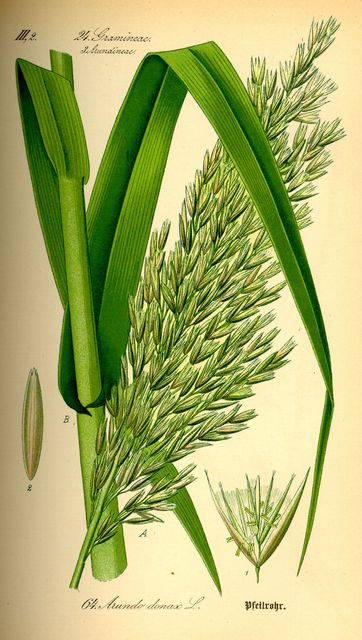
Arundo donax – botanical illustration
The thick, cylindrical stems measuring 3 to 5 cm in diameter resemble those of reeds. These culms or canes are strongly partitioned at intervals by nodes from which the leaves arise. They change colour progressively with time and sun exposure, going from green to straw yellow.
The main attraction of giant reed comes from its very graphic foliage that rustles at the slightest breath of wind. Each stem bears from base to tip large alternate, linear and flat leaves, slightly trailing much like those of maize. Measuring 30 to 60 cm long and 4 to 6 cm wide, they are tapered at the tip and have cutting edges. They remain evergreen in mild climates.
Arundo offers bright green foliage, while its cultivars display blue-green or variegated leaves, green broadly striped with cream-white in Arundo donax ‘variegata superba’, pale yellow in ‘Aureomarginata’ (syn. ‘Golden Chain’) or silver in Arundo ‘Versicolor’.
Flowering of giant reed is of little interest and is moreover rare and unpredictable. From September to November, and only after a long, very hot summer, terminal inflorescences in feathery panicles up to 60 cm high made of pale green spikelets that turn purple at ripeness may appear, borne above the foliage.
Hardy, giant reed grows easily in all regions spared severe frosts. From its Mediterranean origins it retains a relative tenderness, tolerating negative temperatures around -10 °C (sometimes to -12 °C). It readily acclimatises in coastal gardens and in urban gardens sheltered from cold. In harsher climates, grow it in a container.
Giant reed prefers full sun and shelter from cold winds in a deep, fertile soil that stays cool or even consistently moist in summer. It appreciates summer moisture, warmth and fertile soils and grows quickly under these conditions.
With its well‑upright canes, Arundo brings verticality and volume to the garden, from the most natural to the most exotic. It makes excellent hedges and majestic windbreaks or privacy screens in mild-climate gardens. In a large garden, it will also brighten the back of a border, stand at the edge of a pond or pool. Lower variegated varieties will even do well in a small garden or in a large pot on a terrace.

Foliage of Arundo donax / variegated foliage of Arundo donax ‘Variegata’ / spikelet inflorescences
In the past, the culms of the giant reed were transformed into baskets, reed screens, mats, hut coverings, musical instruments, distaffs, etc. Today, Arundo donax is also used to stabilise soils, notably around the Mediterranean basin, and for its impressive potential as a biofuel.
Finally, Arundo donax is commonly used in homeopathy for the treatment of seasonal rhinitis (hay fever).
Main species and varieties
Arundo Ajax, which is the type species, is the most vigorous and the most invasive. It is hardy to -10 to -12°C in well-drained soil. The variegated varieties are a little more sensitive to cold and shorter than the type species. They nevertheless have a less invasive character! It is better to protect them in cold regions or to grow them in pots.
All our Provence canes are offered in buckets that are easy to transplant.
Our favourites
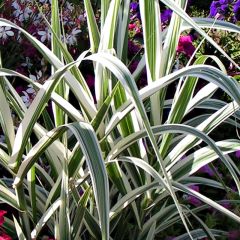
Arundo donax Versicolor
- Flowering time September to November
- Height at maturity 2 m
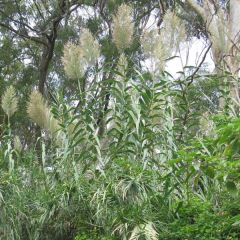
Arundo donax
- Flowering time October, November
- Height at maturity 2,50 m
Discover other Arundo
View all →Available in 1 sizes
Available in 3 sizes
Available in 2 sizes
Available in 1 sizes
Available in 1 sizes
Planting
Where to plant Canne de Provence?
Hardy down to -10/-12°C, the Canne de Provence is easily grown in regions where frosts are short and light. Foliage, less hardy than the stump, can suffer from frost but will regrow vigorously in spring. Variegated cultivars, more tender, will survive in the ground only in regions with a mild climate spared severe cold; elsewhere pot culture in a well-sheltered spot will be necessary. Once well established, after 4–5 years of growth, the plant will offer better hardiness.
It is perfect for a seaside garden exposed to sea spray, a Mediterranean garden or a city garden that is well sheltered.
Native to warm regions, this large grass needs a sunny position sheltered from cold, dry winds that can scorch its foliage — variegated varieties are even more sensitive. For the same reasons, these prefer a non-scorching aspect with dappled sun.
A plant of marshy areas and watercourses, Canne de Provence likes humid places. It will thrive in rich, sandy, deep, cool to moist and well-drained soil. It prefers slightly moist soil in summer, but will hate waterlogged soil in winter, which can cause fatal rot.
However, once well established, it tolerates short periods of summer drought reasonably well.
Before planting, remember that Arundo donax can be invasive where it thrives. Consider carefully location and space you wish to allow, because once in place it will spread without caring for neighbours…
Fortunately, for small spaces or buckets, there are cultivars less vigorous than the species that do not require control by a rootstock barrier!
These canes resistant to strong winds are extremely flexible and never break, even in south-east France swept by the Mistral! Such resilience makes them ideal as effective privacy screens or windbreaks, or hedging to define areas in a large garden.
Depending on mature height, the Canne de Provence will also find a place at the back of evergreen borders, in isolated clumps on pond banks, around a water feature or to bulk up a very wet area of the garden. It can also be grown in large buckets on a terrace or beside a swimming pool.
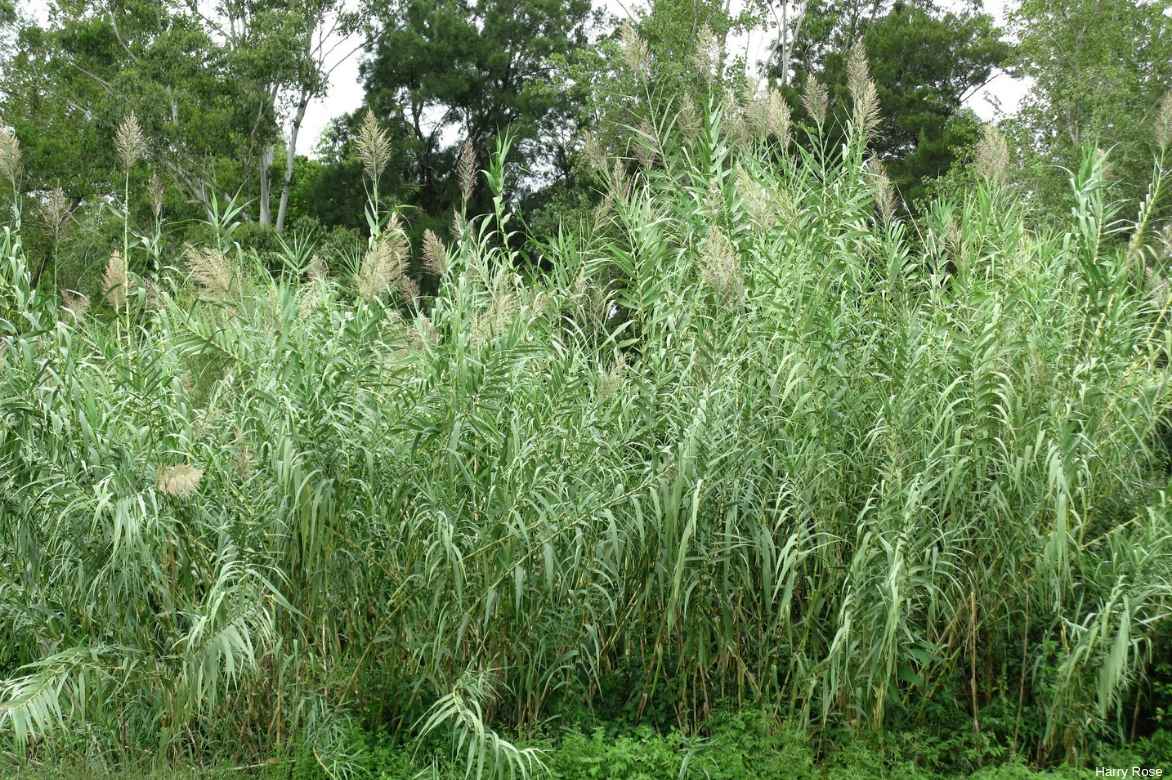
When to plant Canne de Provence?
You can plant the Canne de Provence or Arundo donax between March and June in regions north of the Loire, after frosts, or between September and November in southern regions.
How to plant Canne de Provence?
Relatively undemanding, the Canne de Provence will shoot up quickly if growing conditions and care during the first year after planting are optimal. For good establishment: keep soil moist in summer as this plant must never lack water. Avoid planting in very heavy, compact soil — lighten with well-rotted compost.
In the ground
Our buckets of Canne de Provence are easy to plant. Allow space for this vigorous running grass’s strong growth! Depending on variety, plant 1 to 2 buckets of Canne de Provence per m², up to 3 for variegated cultivars.
- Amend soil with well-rotted compost or manure to enrich and improve structure, especially if very compact.
- Dig a hole two to three times the volume of the rootball
- Place your Canne de Provence in centre of the hole
- Backfill with excavated soil mixed with well-rotted compost
- Firm down
- It needs a lot of water to establish; water generously
- Mulch with wood chips or pine bark
You will limit spread of its running rootstocks with a polypropylene anti-rootstock barrier installed around the plant. Discover detailed explanations in this step-by-step: limiting an invasive plant.
How to plant Canne de Provence in a pot?
Small variegated varieties adapt very well to bucket culture provided you follow watering closely.
- Lay a bed of gravel or clay pebbles in the bottom of a container with drainage holes and at least 50 cm deep
- Set your Canne de Provence in a rich, light mix made of equal parts rose potting compost and garden soil
- Water frequently so substrate never dries out between waterings
Care and maintenance
In the ground
Once well established, Giant Reed requires almost no maintenance but is very water‑hungry. To root properly, young reeds require regular watering during the first two or three years after planting, especially when soil becomes very dry in summer; afterwards they will better tolerate short dry spells.
Spread a natural mulch at the base to reduce watering needs and keep soil sufficiently moist in summer.
This plant is fairly demanding and will look even better in fertile soil: in spring, apply an organic fertiliser.
In cold areas, before winter, protect the stump of young reeds with a thick coat of dead leaves or a straw litter layer; the older they become the more they will gain in hardiness.
Remove faded leaves as they appear.
Each year in March, severely cut clump back to ground level using a pruning shear, cutting culms at the base that are dry or damaged by frost. Regrowth is very rapid and will regrow vigorously, producing large entirely new culms and maintaining a handsome bushy habit. Remove suckers to control spread.
Watch our video: How to prune an ornamental grass
Dried culms make excellent stakes.

In a pot
Giant Reed in a pot must never be without water; avoid letting soil dry out completely between waterings. During active growth, support its growth with liquid fertiliser every two weeks.
In cold regions during winter, overwinter variegated Arundo varieties grown in tubs by sheltering them from frost in an unheated greenhouse or conservatory and reduce watering.
Each year at the start of spring, top‑dress the surface. Repot every 2–3 years.
Particularly robust, Giant Reed has no known pests.
Multiplication
Canne de Provence or Arundo has a natural tendency to spread rapidly, allowing gardeners to obtain new young plants! Propagation is carried out in spring, between April and June by division of the stump or in summer by cuttings.
Clump division
- Moisten soil well to easily extract rootstocks
- With a sharp spade, lift a good mature clump at least 3 years old and take divisions including at least two leafy shoots at edge of the stump
- Replant immediately in planting hole
- Backfill with compost
- Firm down and mulch
- Water copiously then keep soil moist to encourage establishment
And find our tips to properly divide an ornamental grass in a video !
How to take cuttings from Canne de Provence
Propagation by cuttings of rootstocks is also possible between April and July. It is easy to take sections of cane fitted with 1 or 2 buds and simply push them into moist soil so they root in only a few months; they can also be propagated in water.
Propagation by cuttings in water
- Take thin sections of cane about 1 cm thick
- Keep lower leaves
- Place them in a shallow tray with a little water and keep in light
- When cuttings form roots, pot them into buckets filled with potting compost and sand
Associate
Elegant foliage, sometimes variegated with green, cream or yellow, a graphic silhouette, a very striking presence, la Canne de Provence always brings brightness and verticality to a setting. In mild climate, it helps retain a beautiful garden even in winter with its foliage remaining evergreen.
Versatile, this giant grass fits into all gardens whether city gardens, exotic, wild or natural to structure the setting.
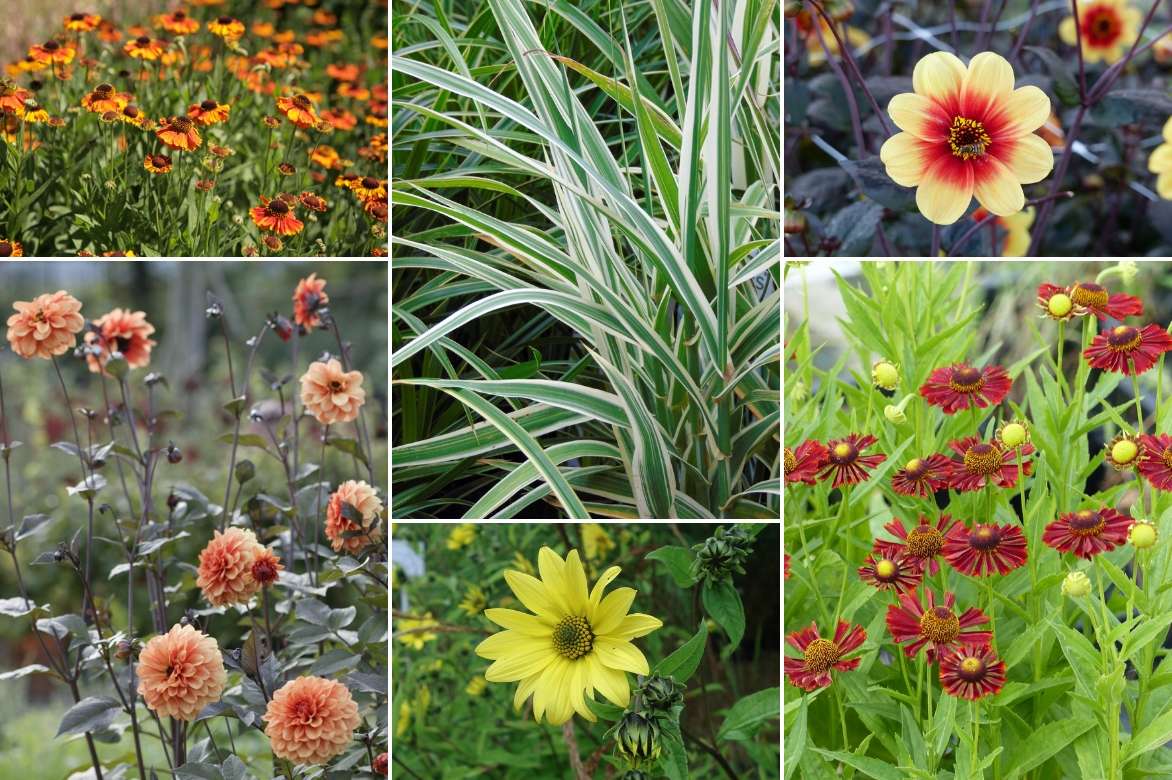
An idea for a late-summer to autumn pairing: Helenium ‘Sahin’s Early Flowerer’, Arundo donax ‘Variegata’, Dahlia ‘Sunshine’, Dahlia ‘David Howard’, Helianthus ‘Lemon Queen’, Helenium ‘Siesta’
It is particularly suited to aquatic scenes in a water garden alongside astilbes, sedges, rushes, goatsbeard or gunneras.
In a shrub border, it will provide backdrop to sacred bamboo, flowering dogwood, spindle or Loropetalum and can bulk out base of strawberry trees and junipers.
In an exotic-themed scene, it will sit naturally alongside large cannas, bamboos, and also palms and castor plants. It will resonate with its cousins, the large grasses such as pennisetums, pampas grasses or miscanthus.
Useful resources
- Discover our range of giant reed and be enchanted by our exceptional collection of ornamental grasses!
- Create an exotic atmosphere thanks to giant reed!
- List of invasive plants in France
- Discover how to get rid of invasive giant reeds
- Subscribe!
- Contents
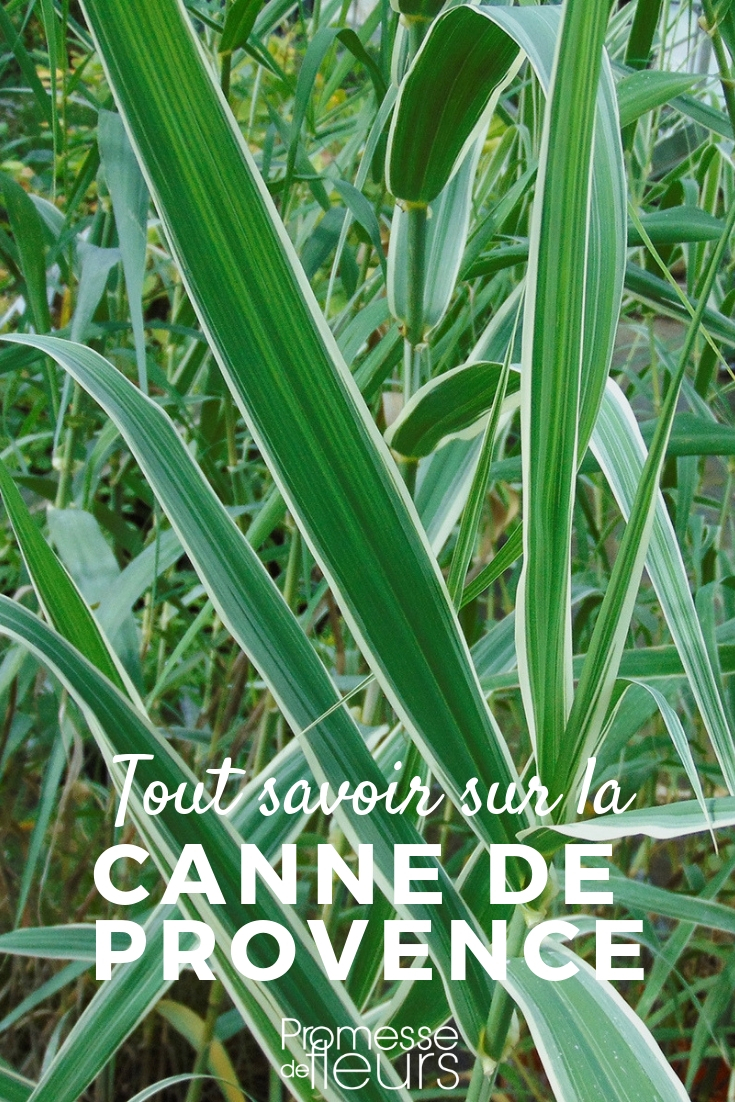































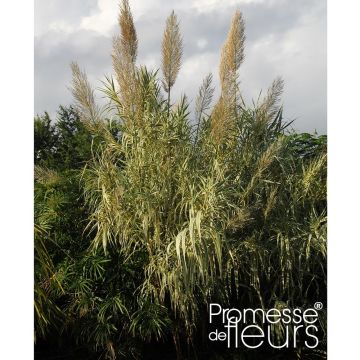




Comments